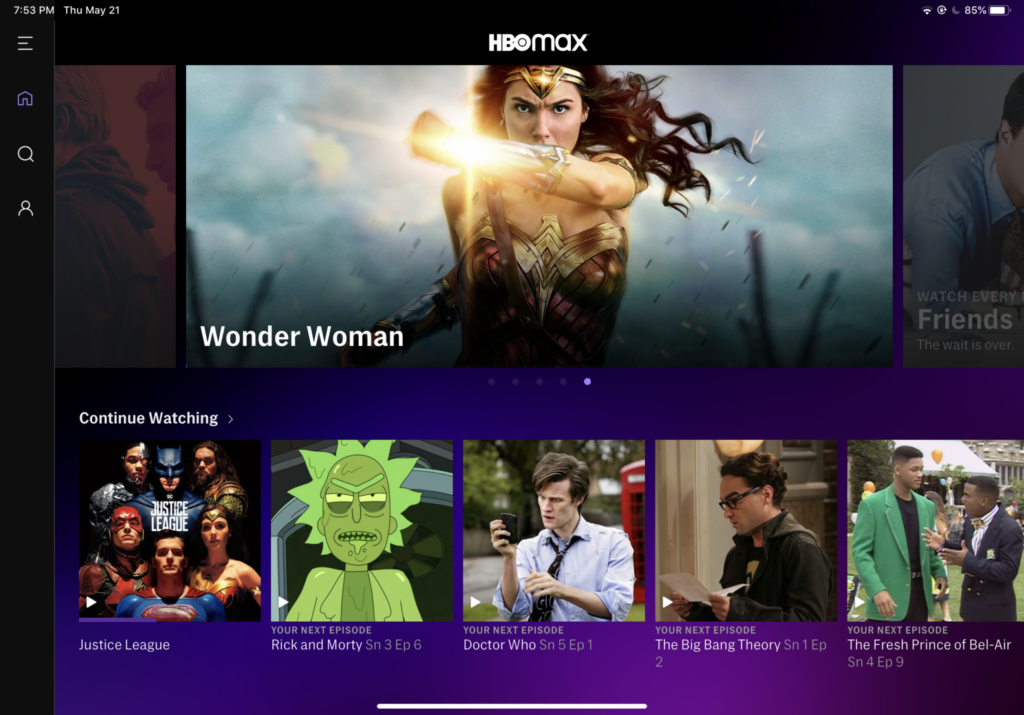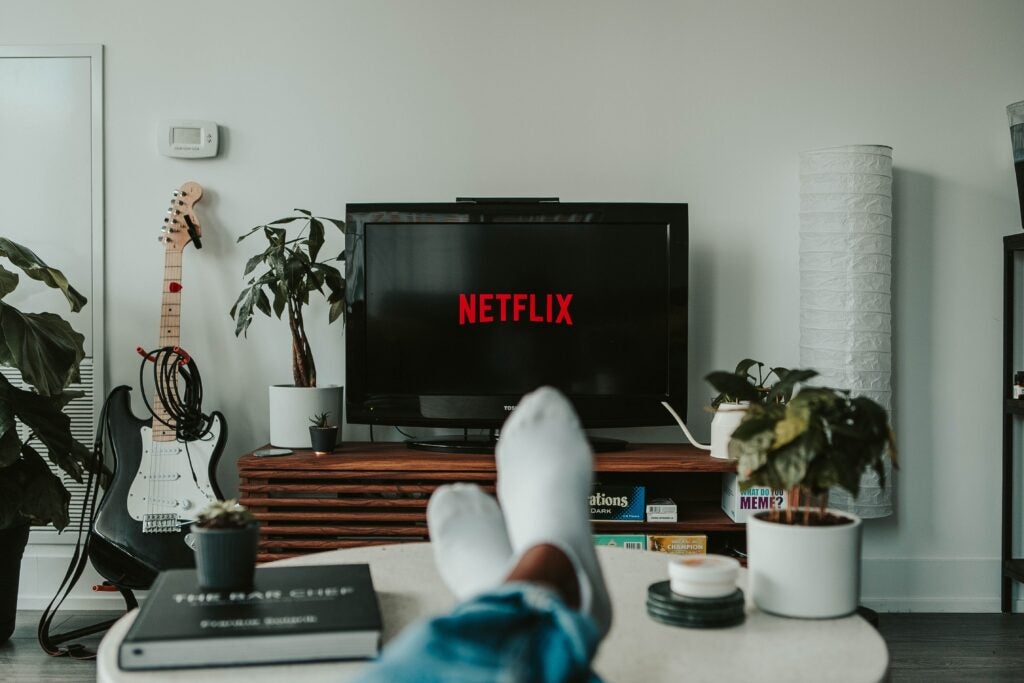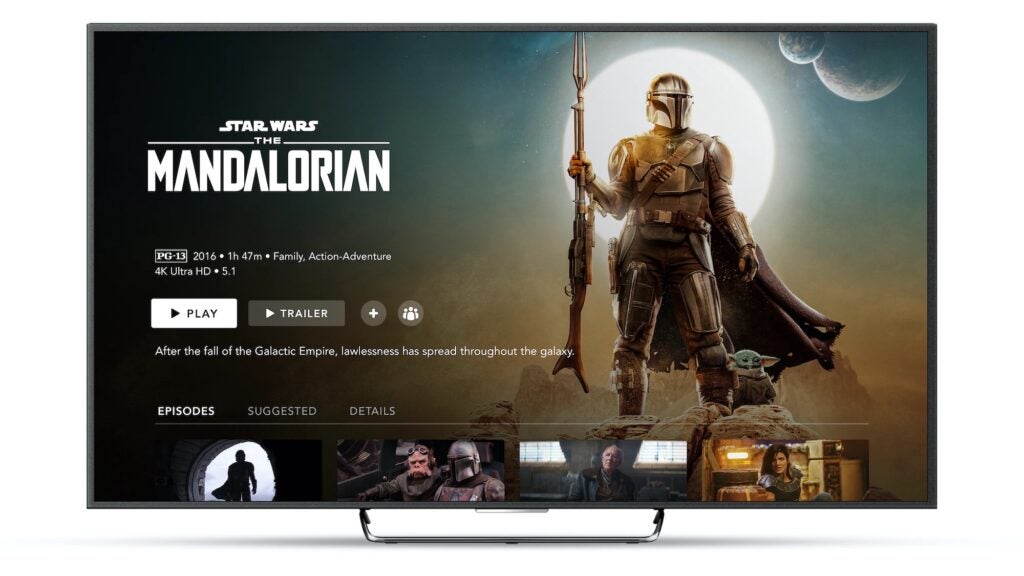How Many Gb Of Data Does Netflix Use
Streaming services are a mutual presence in households everywhere, whether you have cable or not, significant data use is, too. What started with a few core platforms—Netflix, Hulu, Amazon Prime Video—has now exploded into a veritable pantheon of heavy hitters including Disney+ and HBO Max, too as a broad array of more niche services like Crunchyroll (for anime) and Shudder (for award, thriller, and supernatural content). While information technology's dandy to have admission to shows like The Mandalorian at the press of a push button, the increased popularity of streaming means nosotros're using more broadband data than ever. Whether y'all're watching a live effect, like an NFL game or the Academy Awards, or streaming your favorite testify, we are constantly downloading content as we watch information technology. With some companies setting data caps on abode broadband, not to mention the limits most of united states of america have on mobile, it's more important than ever to continue an eye on how much data you're using when y'all watch. To that end, nosotros looked at all the most popular options on the marketplace—both on-demand and alive TV—to run into how much data does streaming live tv use. Here's what nosotros found.
Agreement information and cyberspace speeds
Earlier we dig into the hard numbers, we want to take a moment and explain some of the key terms you'll need to sympathise to accept advantage of this guide. If you spend a lot of time online, you're probably familiar with things like internet speed, information, and resolution. But it's always nice to refresh our memories, and then we're all on the same folio.
Cyberspace connection
Broadband providers refer to internet speeds by measuring the amount of data that can be uploaded and downloaded at a given fourth dimension. Different types of internet connections exist, but the most mutual are cable and fiber. Cable is typically measured in Mbps (megabits per 2nd), while Cobweb is capable of unlocking speeds of up to 1 Gbps (gigabytes per second). Those who stream 4K content and connect multiple devices to the net at once are ameliorate off with fiber—assuming it'southward available in your area—since it offers more bandwidth.
Data
Information refers to the information that'south transmitted to and from the cyberspace. The transmission is achieved through uploads and downloads. Information is exchanged every time you stream a podcast or post a photo on your favorite social media platform.
Data cap
Near home cyberspace plans offer unlimited information, simply some broadband providers have options with a data cap. Let'south say your information cap is set up for 1TB per calendar month. If you go over that cap, you might take to pay an additional fee for extra data, or your connection might get throttled.
Throttling
Throttling is when a broadband provider slows down your internet speeds, and information technology might happen in a couple of different ways: if the provider feels there'due south too much bandwidth congestion and information technology will help optimize things for everyone, or if you've striking a gear up data cap.
Resolution
Mostly, there are four different resolutions: 480p is standard definition; 720p is loftier definition (HD); 1080p is full high definition (Total Hard disk); and 4K is ultra-high definition (UHD). And whether 4K vs. 1080p is correct for you lot is a personal choice influenced by several factors. But one thing's for certain: the higher the resolution, the more data you lot'll consume. Merely invested in a new Apple TV 4K and one of the best OLED TVs on the market? You're more likely to churn through data faster, and then the following metrics will exist particularly useful.
Pop streaming services and how much data they employ

There'south more streaming content to picket than ever, and so it'southward important to know how much data is used by today'southward virtually popular streaming services. With this information in hand, yous can stay under your monthly information cap and avoid getting throttled by your broadband provider.
Based on our enquiry, well-nigh of the "major" on-demand streaming services use roughly the same amount of data per hour depending on the quality of the stream. Some of the platforms provide a breakup of how much data they utilize per 60 minutes, while others simply recommend a minimum cyberspace speed for a consistent, buffer-free experience.
Additionally, some services allow yous to control the quality of your stream, effectively letting y'all control how much data you lot use. Even the ones that allow yous choose, though, will automatically set your stream quality based on the speed and bandwidth of your internet connection. Some services too offering data saver modes that stream at lower resolution, which is practiced if you take a information cap or are on a mobile device out of range of Wi-Fi.
We've gathered official figures from many of the almost popular streaming services currently available to the public. Plain, we practice not feature every service on this list, but what we've seen seems to propose a standardized range of data usage.
Netflix: Netflix provides specific estimates for each of its streaming settings. Standard definition uses up to 0.3 GB per 60 minutes. High definition (720p) uses up to 1 GB per hour. Full HD (1080p) uses up to 3 GB per hour. UHD (4K) uses upward to 7 GB per hr.
DirectTV Stream: DirectTV recommends a minimum of 8 Mbps to deliver an "optimal viewing experience."
Amazon Prime Video: Prime Video recommends a minimum download speed of i Mbps for SD content and v Mbps for Hard disk drive content. Prime Video says information technology volition serve the highest quality streaming experience possible based on the bandwidth speed bachelor.
YouTube: YouTube recommends i.1 Mbps for SD, ii.5 Mbps for Hd 720p, 5 Mbps for Full Hd 1080p, and 20 Mbps for 4K.
Disney+: On Disney Plus, Standard definition streams apply approximately 0.7 GB per hour. Full Hard disk streams use approximately 2 GB of information per 60 minutes. UHD (4K) streams will use approximately 7.7 GB of data per hr.
Peacock: Peacock recommends at least two.v Mbps of bandwidth for Hd streaming.
Hulu: Hulu looks for 3 Mbps for Hulu's Streaming Library, eight Mbps for live streams, 16 Mbps for 4K content.
HBO Max: HBO Max recommends a minimum download speed of 5 Mbps to stream HD video. For the all-time 4K streaming experience, it calls for a download speed of 50 Mbps or college.
ESPN+: ESPN says viewers need at least ii Mbps for an "optimal viewing feel" on ESPN Plus livestreams.
How much data exercise I need?
People aren't just streaming at dwelling; thanks to smartphone apps, it'southward easy to watch TV and movies on the go. But exist wary of how much streaming you do in line at the DMV, because information technology can eat your data programme in a hurry. All of the major carriers offering monthly "unlimited" data options and will throttle your connexion depending on network congestion. A prepaid data programme will permit you to pay ahead for an allotment of data per month. Some options include 5 GB, 25 GB, and 100 GB plans, and while that's plenty for browsing the spider web, listening to music, and uploading photos to social media, it's a little light for heavy streaming of movies and TV.
For those of us who have abode internet with a information cap, picking the correct service will come up down to your usage. If your biggest downloads are 4K streams, a base 1 TB per month information plan should be enough to go past, so long every bit your Boob tube isn't on 24/7. For playing video games, uploading and/or downloading video on your figurer, or doing any number of other things that require transmitting a lot of data, you will likely need to appraise your data usage to effigy out how much you need. Too, continue in heed that data usage adds up much quicker when you have multiple people connecting to your network at once.
Does streaming utilise more data than downloading?

Streaming a picture show in Full HD requires almost the aforementioned amount of bandwidth every bit downloading a picture in Total Hd. Withal, downloading a movie stores a file on your device, so you can watch the file multiple times. If y'all stream the aforementioned movie twice, you will have to apply twice as much data.
That said, virtually streaming services feature settings that automatically suit your stream quality (and the corporeality you download) depending on your bandwidth. Streaming a picture show in 4K may use less data than downloading information technology because the platform adjusts the download at various times over the course of the stream.
How to avoid going over your home internet'south information cap
Similar it or non, the all-time way to avoid going over your home cyberspace information cap is to limit your usage. That ways less browsing, less online gaming, and, yes, less streaming—including YouTube videos and Twitch broadcasts. When you do stream, consider picking a lower quality setting if you're watching an older show or something that isn't visually arresting. Something like an episode of Seinfeld should be fine in Hard disk drive, whereas an epic like Dune on HBO Max is worth using that actress bandwidth and data to stream in glorious 4K.
If your broadband provider offers an app, download it so you can monitor your usage throughout the month. Some Wi-Fi routers also let yous to control your data usage. For case, an Eero router has a companion app that will bear witness yous real-fourth dimension usage for devices that are connected to your network and cutting them off if needed. There's also a characteristic that will let you set schedules and even break Wi-Fi. These features will assist curb your usage if you're afraid of going over whatsoever limits set by your broadband provider.
Which streaming service uses the to the lowest degree data?
Though the differences aren't huge, some streaming services utilise more others. Disney+ said information technology uses approximately 2 GB of data in an hr for a Full HD stream, while Netflix says it uses approximately 3 GB an hour for a stream in similar quality.
If data caps are a concern, you should look out for services that allow you to pick the streaming quality and/or offer information saver modes. Netflix, for example, has a basic plan that only lets yous stream in standard quality, which uses about 0.7 GB of data per 60 minutes.
Keeping an eye on how much data you stream

If you accept a data cap at home or on your phone, information technology's important to be witting near how much of your information you're using when you lot lookout TV or movies. Generally, streaming and live TV services crave a connection speed of approximately ten Mbps and use up to iii GB of data in an hour for a stream in Full HD. While it's hard to go along a tight concord on how much data you employ from moment to moment, that is a guide that can assist you empathize your internet usage.
How Many Gb Of Data Does Netflix Use,
Source: https://www.popsci.com/reviews/how-much-data-does-streaming-live-tv-use/
Posted by: martincouseed1937.blogspot.com


0 Response to "How Many Gb Of Data Does Netflix Use"
Post a Comment